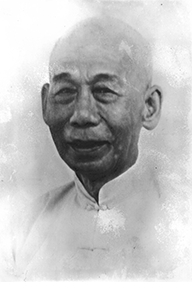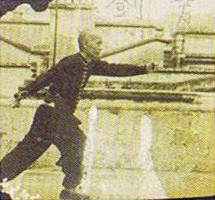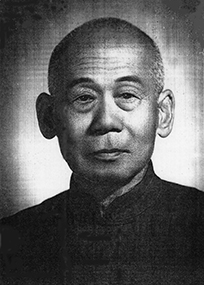 Tang Fung was one of the most famous disciples of Wong Fei Hung had produced. Wong Fei Hung had more than one hundred “in the door” disciples. Some of the most famous ones were: Liang Foon (his #1 disciple, famous for cracking the ground under his feet when he sat in a horse stance), Ling Wan Gai (famous for his “Gwai Gerk”, ghost kicking skills), Chan Din Biu, Lam Tsai Wing (famous for his Saber techniques and writing three books on Hung Ga), Tang Fung (famous for his strict and rigorous training and his “Old Square-Mind” mentality), Sui Low Yuk and Sui Low Ngan (Uncle and Nephew who spread the art to Malaysia), Tak Gan Jow, and Luk Jin Gun.
Tang Fung was one of the most famous disciples of Wong Fei Hung had produced. Wong Fei Hung had more than one hundred “in the door” disciples. Some of the most famous ones were: Liang Foon (his #1 disciple, famous for cracking the ground under his feet when he sat in a horse stance), Ling Wan Gai (famous for his “Gwai Gerk”, ghost kicking skills), Chan Din Biu, Lam Tsai Wing (famous for his Saber techniques and writing three books on Hung Ga), Tang Fung (famous for his strict and rigorous training and his “Old Square-Mind” mentality), Sui Low Yuk and Sui Low Ngan (Uncle and Nephew who spread the art to Malaysia), Tak Gan Jow, and Luk Jin Gun.
Tang Fung was born in Sam Soy village, Gwan Dong province in 1874. During his youth he learned Hung Ga from Sifu Wong Yau and Sifu Yuen Yin, and also studied Mau Shan, a form of folk sorcery. Later he learned from Wong Fei Hung, completing the orthodox version of Hung Ga and becoming Wong’s close disciple.
 Tang Fung was also a participant in the Luk Sin theater incident. In this famous incident Lam Sai Wing, Tang Fung, Tang Yee, Gwan Kwan, and a few of Lam’s disciples became trapped by a rival instructor at the theater. The rival instructor led an attack with about 80 men, while Lam, Tang and his colleagues had fewer than 10. They sustained a few minor injuries. The rival side had a count of 80 people sent to the hospital. Tang, his brother Tang Yee and Lam Sai Wing left town to avoid trouble. Lam went to the Gwang Dong/Gwong Sai border and Tang Fung went to Singapore to work as a miner. Later Tang Fung returned to Gwang Dung.
Tang Fung was also a participant in the Luk Sin theater incident. In this famous incident Lam Sai Wing, Tang Fung, Tang Yee, Gwan Kwan, and a few of Lam’s disciples became trapped by a rival instructor at the theater. The rival instructor led an attack with about 80 men, while Lam, Tang and his colleagues had fewer than 10. They sustained a few minor injuries. The rival side had a count of 80 people sent to the hospital. Tang, his brother Tang Yee and Lam Sai Wing left town to avoid trouble. Lam went to the Gwang Dong/Gwong Sai border and Tang Fung went to Singapore to work as a miner. Later Tang Fung returned to Gwang Dung.
After Wong Fei Hung was quite old, Tang Fung and his brother Tang Yee opened a school called “Yee Yung Tong” (Chivalrous Brave Hall), After Wong’s Death, Madame Mok Gwai Lan, who was Wong’s Wife, taught an all women’s class at Tang’s school. After the start of the Sino-Japanese war in 1937, Tang moved to Hong Kong. He established a medicine shop at Sum Soi Bo and helped many people with medicine; always having a good heart and never charging for treatments if one could not afford it.
Tang Fung also married twice but had no sons. Tang’s second wife, Ho Fan, was the one Tang’s students called Simo. Ho Fan was taught the Gi Mo Cern Do (mother & son twin swords) and often demonstrated in fighting sets with Tang.
 Tang lived in Kowloon, Wang Gok, But Lan Street. He taught six days a week, even though he was in his 70′s. Master Tang taught 3 days on the Kowloon side at the jewelry association, then would take a one hour ferry on alternating days to the Hong Kong side 3 times a week to teach at the Shau Kay Won Fish Market Association. He also took over the position as head of security from Lam Tsai Wing at the Shau Kay Won Fish Market. During his years in Hong Kong, Tang established a strong reputation for himself. His teaching was known to emphasize hard stance training and strict detail to forms and applications. Tang was nicknamed “Lo Wan Ku” which means “Old Square Mind.” This was in reference to Tang’s stubborn traditionalism. Tang Fung’s daughter, Tang Sou Kin, broke from his traditionalist outlook and was heralded as Queen of the lion dance, during the 1920′s. At that time women were not allowed to participate in lion dance, for which Tang Fung was well known. During the early 1950′s, Tang himself, performed a special command performance lion dance for Queen Elizabeth even though he was well on in years.
Tang lived in Kowloon, Wang Gok, But Lan Street. He taught six days a week, even though he was in his 70′s. Master Tang taught 3 days on the Kowloon side at the jewelry association, then would take a one hour ferry on alternating days to the Hong Kong side 3 times a week to teach at the Shau Kay Won Fish Market Association. He also took over the position as head of security from Lam Tsai Wing at the Shau Kay Won Fish Market. During his years in Hong Kong, Tang established a strong reputation for himself. His teaching was known to emphasize hard stance training and strict detail to forms and applications. Tang was nicknamed “Lo Wan Ku” which means “Old Square Mind.” This was in reference to Tang’s stubborn traditionalism. Tang Fung’s daughter, Tang Sou Kin, broke from his traditionalist outlook and was heralded as Queen of the lion dance, during the 1920′s. At that time women were not allowed to participate in lion dance, for which Tang Fung was well known. During the early 1950′s, Tang himself, performed a special command performance lion dance for Queen Elizabeth even though he was well on in years.
According to Master Yee, Tang was famous for a weapon that was not a standard Hung Ga weapon. He was known for his Ngauh Gwat Sin (Beef Bone Fan) or Iron Fan techniques, which became renowned in Hong Kong, although his skill was rarely demonstrated. Tang produced his own roster of well known students & disciples:
Yuen Ling – Successor to Tang Fung – Represented in the U.S. by Master Frank Yee of Yee’s Hung Ga Kung Fu Academy.
Lau Kai Ton – Represented in the U.S. by New Mexico’s Master Frank Rivera.
Luk Gan Wing – Represented in Ontario, Canada by his son.
Wong Jo – A Hong Kong jewelry maker who still can be found on any given day at the Shau Kay Won fish market association.
Ho Lap Tien – Represented in the U.S. by Philadelphia’s Master Cheurng Shu Pui.
Cheung Tai Hing – Represented in the U.S. by New York’s Master Wan Chi Ming.
Jao Wing Duk – Represented in Spain by Master Lam Chuen Ping.
Kwan Kei Tin
Won Lei
